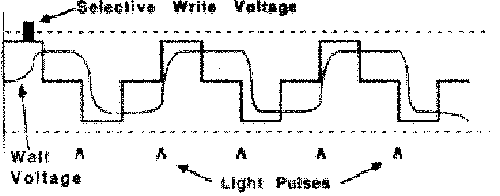The History of Plasma Displays
By Jamie Hutchinson
By 1963 Bitzer had demonstrated the success of his now-legendary
automated teaching system, PLATO, within the limited,
controlled environment of the Coordinated Science Laboratory.
Bitzer and CSL director Daniel Alpert understood that
putting PLATO in practice for large numbers of students—in
essence, transforming it from a classroom into a system—would
require more than replacing the ILLIAC I, a relic from
the days of "big iron" that served as the
original mainframe for PLATO's time-sharing network.
A real-world PLATO would also eventually require a better
way of visually mediating the exchange between computer
and student.
At that time, almost all devices for interacting visually
with computers were alphanumeric displays that could
only render letters and numbers, not the graphics required
for teaching and learning many subjects. Bitzer rigged
a system using radar display tubes that could digitally
read pictures and alphanumeric characters from ILLIAC
I, then transmit the images by cable to TV terminals
at each student station.
 The earliest versions of PLATO used TV sets for
the student terminals. ILLIAC digitally sent graphical
and alphanumeric data to Raytheon double-electron-gun
storage tubes, which were designed to display radar
signals and transmit the displayed images. One electron
gun would write the data from ILLIAC to the storage
tube display, while the other rescanned that display
in TV format for cable transmission to the student's
TV terminal (shown above). Slides could also be scanned
and added to the TV output. (D. L. Bitzer)
The earliest versions of PLATO used TV sets for
the student terminals. ILLIAC digitally sent graphical
and alphanumeric data to Raytheon double-electron-gun
storage tubes, which were designed to display radar
signals and transmit the displayed images. One electron
gun would write the data from ILLIAC to the storage
tube display, while the other rescanned that display
in TV format for cable transmission to the student's
TV terminal (shown above). Slides could also be scanned
and added to the TV output. (D. L. Bitzer) The system worked well enough while PLATO was in a
proof-of-concept phase. However, the constant refreshing
of the image that is required in a cathode ray tube,
while fine for TV, didn't lend itself well to the sustained
display required for graphics. The tubes had no memory
for holding an image, and the cheap computer memory
that makes tubes suitable for graphics today was a dear
resource in the 1960s. PLATO would require a better
display for the long haul.
Bitzer enlisted Willson, then a graduate assistant,
and Slottow, then a research engineer, in the task of
exploring how a matrix of discrete neon cells might
be driven by a high-frequency ac current, using capacitors
at each cell so that individual cells, or pixels, could
be addressed. The big breakthrough came one summer evening
as Bitzer and Slottow waited outside CSL for their wives
to pick them up after work. They began discussing the
project in terms of its barest essentials and realized
that the simplest configuration would be to exploit
the natural capacitance of the glass on either side
of a panel, which could be done by placing electrodes
on the outside of each cell, separating the driving
current from the gas.
Next morning, the team set about building a new device.
With Willson doing most of the handiwork, they ultrasonically
drilled a hole fifteen thousandths of an inch wide into
a thin glass slide, then sandwiched that slide between
two others. They deposited thin-film gold electrodes
on the outside surfaces to carry a high-voltage driving
source. They sealed the sandwich with epoxy on three
sides and glued it to a vacuum pump on the fourth, then
pumped it clean and backfilled it with neon.
Power on. Blue.
It was July 1964, and the first ac plasma display panel
had been built. The panel's single cell operated on
the fundamental rules that govern the millions of cells
in one of today's panels.

A 4 x 4 pixel plasma display. Graduate student
Brij Arora (MSEE '68, PhD '72) built the first multipixel
display. "We could address the lines to write
the character or erase it. It was a very exciting
thing," recalled Arora. (D. L. Bitzer)
After this initial success, the team learned that nitrogen
from the air had leaked into their cell, accounting
not only for its blue hue, but also for its good "memory
margin"—its property of remaining lit in
the presence of a "sustain" voltage significantly
lower than the "breakdown" voltage necessary
to initiate the discharge. By 1967, the inventors had
figured out how to achieve good memory margin using
just neon, and they had developed the driving circuitry
necessary to address a large array of pixels. (Alpert
had kept Bitzer's research under his wing after becoming
graduate college dean in the mid-1960s. After the move,
Bitzer's lab was renamed the Computer-based Education
Research Laboratory.) That year, they built a 16 x 16
panel that glowed orange, thanks to the purer neon mixture.
PLATO screens and other plasma panels for years to come,
here at the U of I and beyond, would radiate the same
orange.
 A 16 x 16 pixel "UI" display from 1967.
(D. L. Bitzer)
A 16 x 16 pixel "UI" display from 1967.
(D. L. Bitzer)

In its "on" state, a plasma cell actually
flickers thousands of times per second. Every time the
ac sustain voltage reverses polarity, its corresponding
field within the cell realigns with an alternating "wall
voltage" emanating from the glass, creating a total
cell voltage sufficient to ignite the discharge. A new
wall voltage of opposite polarity then begins to build
up until it cancels the cell voltage, extinguishing
the discharge, and a new cycle begins.
|